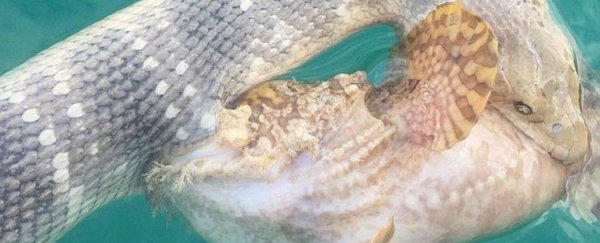One of the world's most venomous fish has been caught in a violent stalemate with a deadly sea snake near a shipwreck off the coast of Darwin in Australia.
"With curiosity we motored over to find this massive thick sea snake close to 2 metres long, with a poisonous fish in its mouth," Australian spear fisherman Rick Trippe told The Daily Mail about the grotesque encounter. "The fish had a great hold on the sea snake and both looked very sad. I'm not too sure I've ever seen a snake looking sad before."
Frowny faces all round, but these two had their chance to make a clean break from their bloody death grip, and they didn't take it. An experienced snake-handler, Trippe felt sorry for the pair and was able to wrench them apart by gripping the snake under its gaping jaw - after he'd taken advantage of the stellar photo opportunity, of course.
But as far as the snake was concerned, it was worth going in for another bite. "I'm silly but not mad. I knew this was dangerous. I knew if I grabbed it I wouldn't get bitten," Trippe told the BBC. "I asked my mate to take a couple of photos - he wasn't too keen but he took them. I could hear the fish croaking so I let them both go, but the snake made a beeline back to the fish."
The snake must have known it was onto something, because Trippe reports that it ended up killing the stonefish. But its victory was likely short-lived - quite literally - because the stonefish presumably used one or many of its 13 venomous spines on its opponent at some point during the altercation.
Found throughout Australian waters and in temperate waters of the Indo-Pacific region, stonefish wield a venom that the University of Adelaide in Australia describes as having "neurotoxic, myotoxic, cardiotoxic and cytotoxic effects in experimental animals". What this means is it attacks an array of biological functions all at once, and while no confirmed human deaths from a stonefish sting have been reported in Australia, deaths have occurred in the Indo-Pacific.
"Instant and severe pain is a constant feature of stings, followed by local swelling, which may be marked, tenderness and a blue discolouration of skin surrounding the sting penetration site," the university reports. "Dizziness, nausea, hypotension, collapse, cyanosis and pulmonary oedema have been described, though are by no means common. Tissue necrosis at the sting site is not seen."
And now that you've met one of the world's most venomous fish, you can watch Destin from Smarter Every Day milk it:
